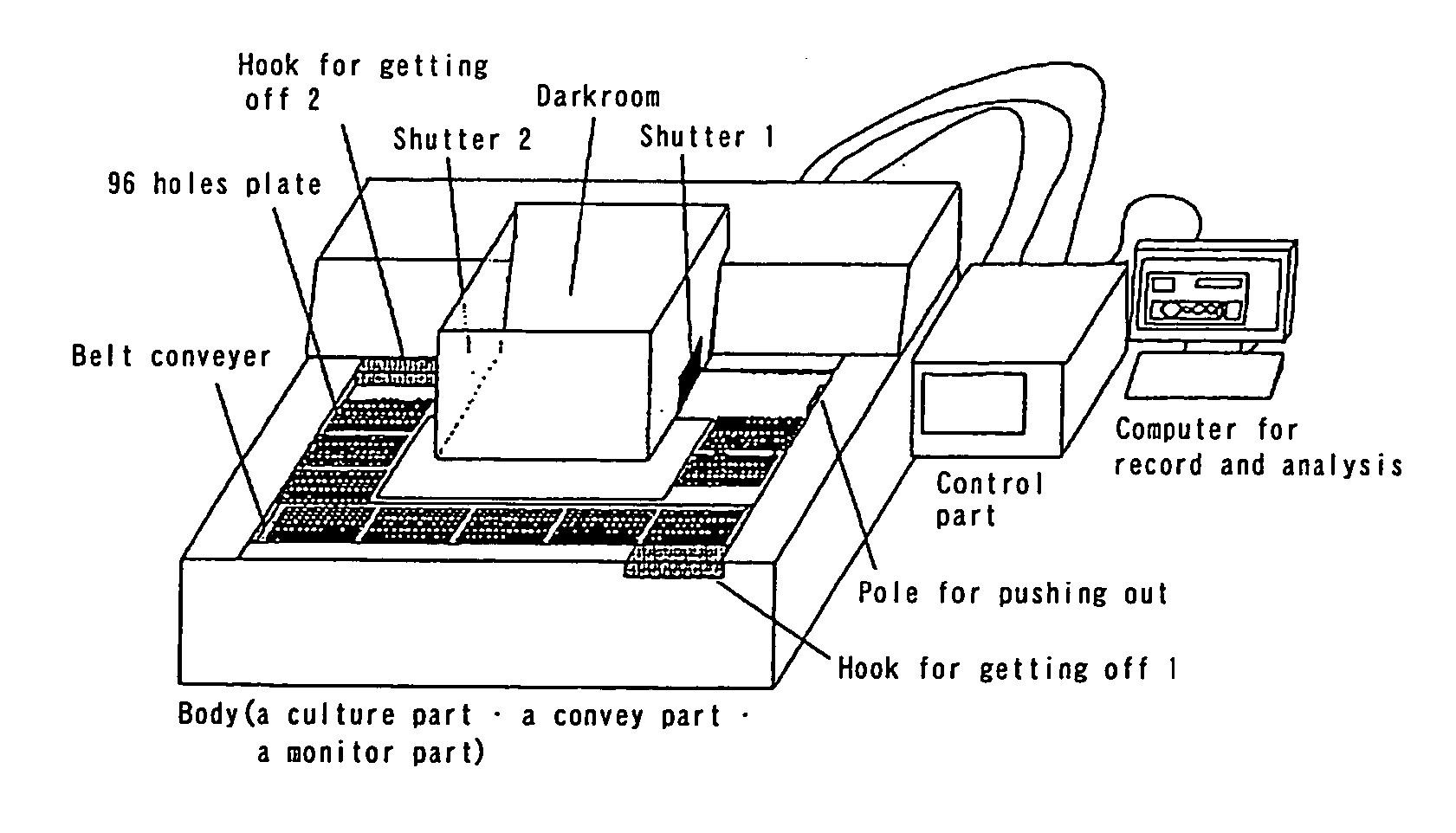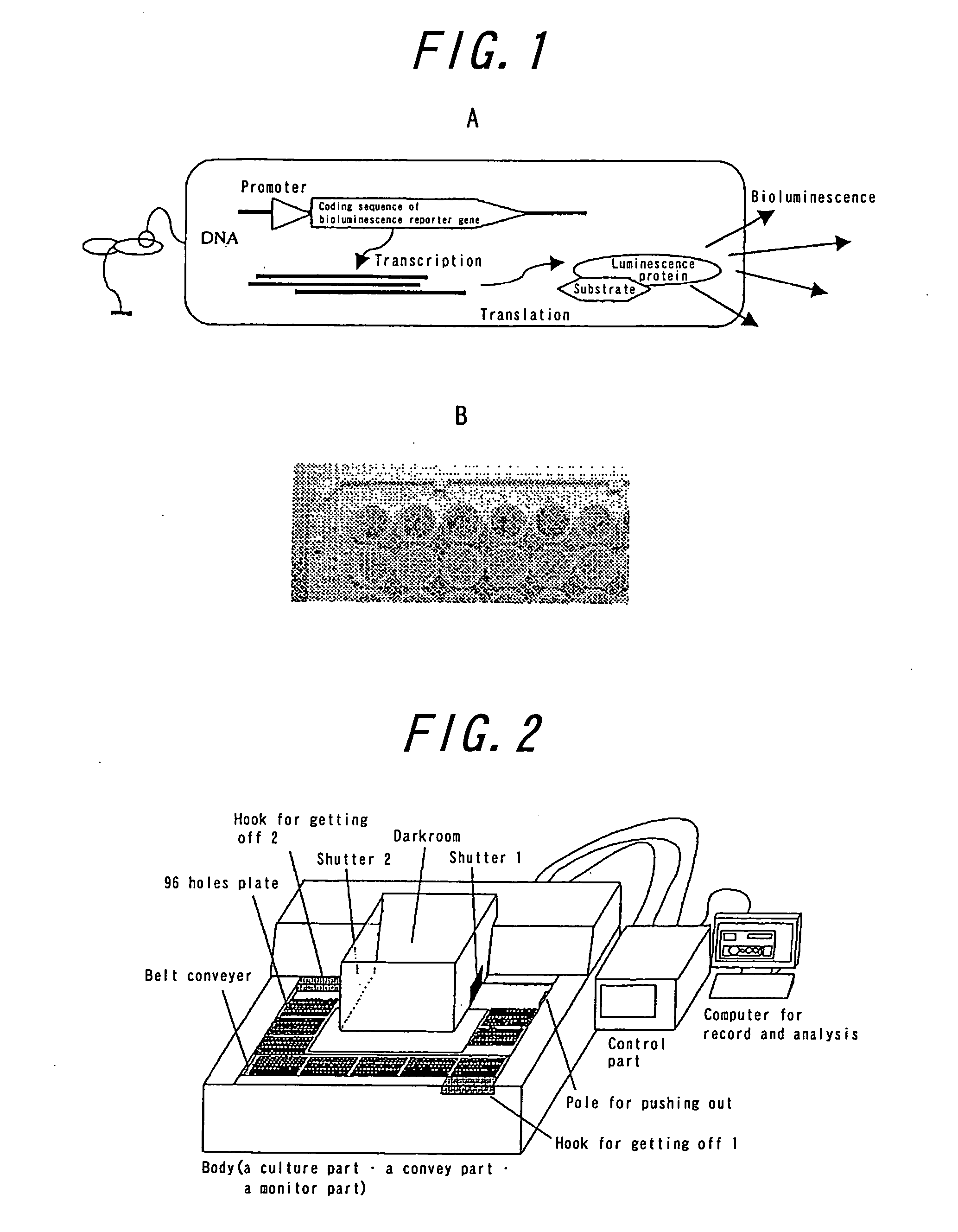Apparatus for monitoring bioluminescence of biological samples
a bioluminescence and apparatus technology, applied in the field of apparatus for monitoring the bioluminescence of biological samples, can solve the problems of difficult comparison and investigation of data every experience, the inability to conduct functional analysis of all genes, and the need to destroy a cell in these methods
- Summary
- Abstract
- Description
- Claims
- Application Information
AI Technical Summary
Benefits of technology
Problems solved by technology
Method used
Image
Examples
example 2
[0074] Next, there is examined an influence of a temperature on the monitoring sensitivity. As a standard light source is used CXS-2011 made by Aloka Co., Ltd. After the standard light source is placed in the well of the plate, a counting value of the well is monitored under temperature environments of 15, 20, 25, 30, 35, 40, 45 and 50° C.
[0075] The results are as follows. In order to clarify what temperature range can be used in the apparatus for monitoring the luminescence according to the invention, the luminescence is monitored under various temperature conditions about the main body of the apparatus (the culture part, the convey part and the monitoring part) (FIG. 12). When the monitoring temperature is raised from 15° C. to 50° C. every 5° C., the counting value of the background increases from 3 cps to 90 cps. On the other hand, the counting value of the standard light source is constant at 2.0×105 cps. As seen from this result, the monitoring of the luminescence in the appa...
example 3
[0076] The monitoring of a bioluminescence reporter strain of Arabidopsis is carried out below. As a sample for monitoring the bioluminescence is used a bioluminescence reporter strain CAB2::LUC of Arabidopsis. (Millar et al., 1992, Plant Cell Vol. 4, p 1075-1087). This stain is a stain wherein a luminescence reporter gene connected a region for encoding luciferase gene LUC of a firefly down the stream of the promoter region of CAB2 gene of Arabidopsis encoring a chlorophyll a / b binding protein is transfused to a genome of a wild type strain C24, and shows a bioluminescence rhythms with period lengths of about 24 hours under constant light condition by being controlled with a circadian clock. Also, the strain shows a decrease of an amount of the bioluminescence and an elongation of the period of the rhythms of the bioluminescence when a light intensity irradiated during culture is decreased. (Millar et al., 1992, Plant Cell Vol. 4, p 1075-1087; Somers et al., 1998, Development Vol. ...
example 4
[0081] The monitoring of the luminescence is carried out by using a luminescence reporter strain of thermophilic blue-green bacterium.
[0082] A psbA1 luminescence reporter strain of thermosynechococcus elongates is used. This strain is a strain wherein a luminescence reporter gene connected to the luciferase gene operon (X1 luxAB) from Xenorhabdus luminescence belonging to thermoduric bacteria at the downstream of the promoter sequence of psbA1 gene of T. elongates is gene-transfused to the genome of the wild type. The rhythm of the bioluminescence can be observed by adding a luminous substrate to psbA1 luminescence reporter strain because the transcription activity of psbA1 gene varies in a daily periodicity and shows a circadian rhythm. A colony is formed by cultivating a cell of psbA1 luminescence reporter strain on BG-11 solid medium at 52° C. under a continuous irradiation of a white light of 50 μmol m−2 s−1. In each well of the plate is poured 20 μl of BG-11 liquid medium, and...
PUM
 Login to View More
Login to View More Abstract
Description
Claims
Application Information
 Login to View More
Login to View More - R&D
- Intellectual Property
- Life Sciences
- Materials
- Tech Scout
- Unparalleled Data Quality
- Higher Quality Content
- 60% Fewer Hallucinations
Browse by: Latest US Patents, China's latest patents, Technical Efficacy Thesaurus, Application Domain, Technology Topic, Popular Technical Reports.
© 2025 PatSnap. All rights reserved.Legal|Privacy policy|Modern Slavery Act Transparency Statement|Sitemap|About US| Contact US: help@patsnap.com



